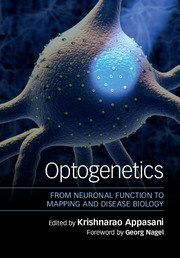Book contents
- OptogeneticsFrom Neuronal Function to Mapping and Disease Biology
- Optogenetics
- Copyright page
- Dedication
- Contents
- Contributors
- Foreword
- Preface
- Part I Optogenetics in Model Organisms
- Part II Opsin Biology, Tools, and Technology Platform
- 6 Sodium and Engineered Potassium Light-Driven Pumps
- 7 Methods for Simultaneous Electrophysiology and Optogenetics In Vivo
- 8 Application of an Optogenetic Technique to a Study of Activity-dependent Axon Growth in the Developing Cortex
- 9 Development of an Optogenetic Tool to Regulate Protein Stability In Vivo
- 10 Photoactivatable Nucleotide Cyclases for Synthetic Photobiology Applications
- 11 Bioluminescence Activation of Light-sensing Molecules
- Part III Optogenetics in Neurobiology, Brain Circuits, and Plasticity
- Part IV Optogenetics in Learning, Neuropsychiatric Diseases, and Behavior
- Part V Optogenetics in Vision Restoration and Memory
- Part VI Optogenetics in Sleep, Prosthetics, and Epigenetics of Neurodegenerative Diseases
- Index
- Plate Section (PDF Only)
- References
6 - Sodium and Engineered Potassium Light-Driven Pumps
from Part II - Opsin Biology, Tools, and Technology Platform
Published online by Cambridge University Press: 28 April 2017
- OptogeneticsFrom Neuronal Function to Mapping and Disease Biology
- Optogenetics
- Copyright page
- Dedication
- Contents
- Contributors
- Foreword
- Preface
- Part I Optogenetics in Model Organisms
- Part II Opsin Biology, Tools, and Technology Platform
- 6 Sodium and Engineered Potassium Light-Driven Pumps
- 7 Methods for Simultaneous Electrophysiology and Optogenetics In Vivo
- 8 Application of an Optogenetic Technique to a Study of Activity-dependent Axon Growth in the Developing Cortex
- 9 Development of an Optogenetic Tool to Regulate Protein Stability In Vivo
- 10 Photoactivatable Nucleotide Cyclases for Synthetic Photobiology Applications
- 11 Bioluminescence Activation of Light-sensing Molecules
- Part III Optogenetics in Neurobiology, Brain Circuits, and Plasticity
- Part IV Optogenetics in Learning, Neuropsychiatric Diseases, and Behavior
- Part V Optogenetics in Vision Restoration and Memory
- Part VI Optogenetics in Sleep, Prosthetics, and Epigenetics of Neurodegenerative Diseases
- Index
- Plate Section (PDF Only)
- References
- Type
- Chapter
- Information
- OptogeneticsFrom Neuronal Function to Mapping and Disease Biology, pp. 79 - 92Publisher: Cambridge University PressPrint publication year: 2017
References
- 2
- Cited by



